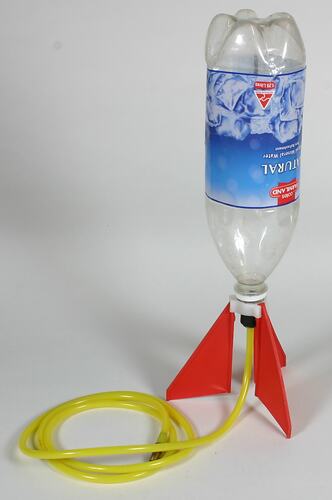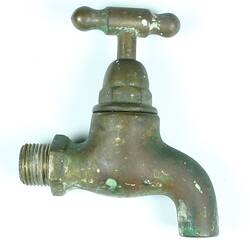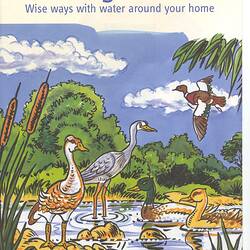Summary
Toy water rocket attached to generic water bottle.
Acquired as part of the Museum Victoria 'Curator for a Day project', undertaken in October 2007. In light of increasing water shortages, the use of this style of game was felt by the donor to now be inappropriate, hence the donor's inclusion of it in the 'Curator for a Day' project.
The water rocket is believed to have been purchased from the Museum Victoria's Scienceworks shop. It is a simple toy that uses pressure in a plastic hose to power a rocket, which is made up of upside down bottle filled with water, inserted into a free standing plastic base. Once pumped with air, pressure would build inside the hose, and eventually launch the bottle filled with water varying distances into the air.
The 'Curator for a Day project' was a collaboration between the Williamstown Environmental Neighbourhood Cluster and Museum Victoria's Water Smart Home project. Students were required to nominate objects relating to water conservation and changing water behaviour for inclusion in the Museum's Water Smart Home collection.
The Williamstown Neighbourhood Cluster is made up of Williamstown High School, Williamstown North Primary School, Williamstown Primary School and Spotswood Primary School. The cluster aims to develop a model for environmental education through active learning opportunities through local community partnerships. Students research, develop understanding and actively engage in environmental projects within their neighbourhood.
Physical Description
Red, white and yellow plastic attachment into which an updside down softdrink bottle is inserted. The free standing base is red plastic and comprises three triangular shaped legs. A yellow hose with a spring loaded valve at one end connects to a white tap-like fitting at the (top) centre of the free-standing base. The upside down softdrink bottle fits into this white tap-like fitting. A 'Coles Farmland' brand empty bottle of natural mineral water is inserted into the free standing base. The 1.25 litre bottle is clear plastic with a blue label around the exterior. The label is blue, with pictures of icecubes and white and red writing.
Significance
This 'Curator for a Day' collection of water related objects is historically and technically significant on both a practical and conceptual level. Several of the objects (hose attachment, sprinkler fitting, garden tap and car wash) are once common water related household and garden objects which reflect water behaviours and practices that have become outdated over recent years. Similarly, the novelty and game items reflect the way that water used feature in leisure activity and how this behaviour has changed. There is a need to collect these contemporary objects while they are in the process of being replaced but are still relatively common and therefore accessible for donation/acquisition. The collection is historically and technically significant as it offers insight in what this group of upper primary and lower secondary school students feel to be important objects to collect and conserve for the future. This in turn highlights how they perceive the current water crisis as well as how they perceive museums and the types of contemporary objects that should be collected.
The Curator for a Day collection of objects is also a very practical critique of water use and perceptions of wastefulness. It documents the current water use practices of this group of students and the change that is occurring in their own life time. It is an extremely tangible and insightful reflection of their own lived history. Acquiring this collection is also a dynamic way of documenting the unique 'Curator for a Day' project. In doing so, the evolution of the Water Smart Home program as well as how it adapted to the changing needs of the community is captured. In addition, the differing ways that Museum Victoria is engaging with the community is documented by the acquisition of this collection.
This object is strategically applicable to the Water Smart Home Project and broader issues of sustainability. This collection of objects is directly connected to the public program and water related heritage collection components of the Water Smart Home website. It is also representative of responses to environmental issues and to water conservation in a domestic context.
More Information
-
Collection Names
-
Collecting Areas
-
Acquisition Information
Donation from Emma Foulstone, Oct 2007
-
Partner Organisation
Williamstown Environmental Neighbourhood Cluster, Williamstown, Greater Melbourne, Victoria, Australia, 2007
-
Collector
Water Smart Home Project, Melbourne, Greater Melbourne, Victoria, Australia, 2007
-
Other Association (See Comments)
Scienceworks, Museum Victoria, Melbourne, Greater Melbourne, Victoria, Australia, 2000-2007
This item (not the softdrink bottle) was believed to have been purchased from Scienceworks shop. -
Inscriptions
Printed on label of plastic bottle: Coles FARMLAND / NATURAL / Natural Mineral Water Pure Refreshment / AUSTRALIAN MADE / 1.25 Litres [Extensive text]
-
Classification
-
Category
-
Discipline
-
Type of item
-
Overall Dimensions
150 mm (Width), 120 mm (Depth), 393 mm (Height)
Length of yellow hose: 1470mm
-
References
[Link 1] Viewed by LDH 3.12.08 [Link 2] Viewed by LDH 3.12.08
-
Keywords
Conservation, Preservation, Sustainability, Water Conservation, Water Consumption, Water Smart Home, Games


